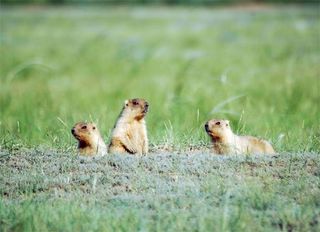Being Bullied Has Its Benefits for Groundhogs

Playing the scapegoat for bullying can actually boost a groundhog's chances of passing on its genes, researchers have found. That's because the victimized animal often enjoys being at the center of a huge social network – a position that has benefits beyond the costs of being bullied.
This tactic may only work well for groundhogs (marmots), whose aggressive interactions are relatively tame compared with chimp battles or human high school students shoving one another into lockers. But the finding that hostile relationships can have benefits still amazed researchers who have spent decades studying the marmots.
"It really opened our eyes to the importance of aggressive interactions for maintaining social structure," said Daniel Blumstein, chairman of the department of ecology and evolutionary biology at the University of California, Los Angeles.
That's not the only surprise. Blumstein and his colleagues found that victim tendencies were inherited, but not the tendencies that led marmots to become social bullies and act aggressively. From a genetic inheritance standpoint, what's done to a marmot matters more than what the marmot does to others.
Bully marmots still enjoyed benefits such as having more mating chances, whereas marmot victims suffered less reproductive success. But the benefits of being at the center of attention in a social network appeared to outweigh the individual costs of being bullied, Blumstein and his colleagues suggested.
That makes sense when considering that marmots that were the victims in hostile interactions also had many friendly connections with other marmots – their central status in the social network cut both ways.
"If it's beneficial to be in a group, you have to tolerate some [aggression] because everyone can't be Alpha," Blumstein told LiveScience.
Sign up for the Live Science daily newsletter now
Get the world’s most fascinating discoveries delivered straight to your inbox.
The researchers have captured, marked and observed marmots in the Rocky Mountain Biological Laboratory in Colorado since 1962. They followed the relationships of 152 yellow-bellied marmots over a six-year period for this new study, which is detailed in the Nov. 29 online edition of the journal Proceedings of the National Academy of Sciences.
Blumstein's ready enthusiasm for marmots became clear when he referred to his "inner marmot" during a discussion about an earlier study. He also described himself as "both an enthusiast and a skeptic" when using social networking statistics to study animal behavior.
"What I like is they're very well defined and get at specific social attributes," Blumstein explained. "But I'm a skeptic in that they have to give us certain insights to be useful."
In this case, the researchers went looking for social network traits that ended up being inherited, because they reasoned that only evolutionarily important traits would be passed on genetically. Their observations led to the surprise findings.
Still, Blumstein cautioned that the findings about hostile relationships and social networking will likely differ for each animal species, depending upon how dangerous the social aggression is for individual animals. He described marmots as getting "snappy at each other at times," but being largely tolerant.
"Relationships aren't just all roses," Blumstein said. "But the relationships seem to be what are important."
10 Things That Make Humans Special
Understanding the 10 Most Destructive Human Behaviors

